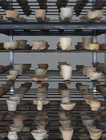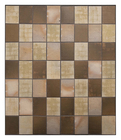excerpt from Jan Guy, 'Travelling the Many Lines of Place: an essay on the work of 2018 Biennale of Sydney artist, Yasmin Smith', The Journal of Australian Ceramics (forthcoming issue, July 2018.
In 2016, Yasmin Smith made several tonnes of clay from pulverised sandstone dust, refuse from the massive excavation at Barangaroo Point during the redevelopment of the Sydney Harbour Foreshore site. Clay from the Barangaroo project has been incorporated into Drowned River Valley, an ambitious, three-part installation for the 21st Biennale of Sydney that accumulated on Cockatoo Island earlier this year over several months. To mark the culmination of the three-year project, Smith has reconfigured Drowned River Valley in the gallery space, allowing the viewer an intimate experience of the work quite different to its sprawling installation on Cockatoo Island.
During the weeks spent by the salty waters of Sydney Harbour during the Barangaroo project, Smith became interested in the history of salt production in New South Wales, the utilization of sodium-rich plants by indigenous peoples, the salt co-operatives of early colonial settlements along Sydney’s extensive river system as well as pre-industrial salt evaporation furnaces. The local history of salt then fed into her research on the tradition of ceramic salt glazing techniques – a process that involves a material transformation of the clay body itself as opposed to the separate application of glaze material onto a clay body.
Salt is a chemical compound essential to the existence of life. Throughout history and across human cultures it has been a valuable resource integral to systems of science, economics, anthropology, archaeology, geology, hydrology, spirituality and politics as well as bearing significance of a more cosmological nature. Drowned River Valley is an activity for the empirical and aesthetic understanding of the presence of salt in its various manifestations in and around Sydney Harbour as a core element of intersecting living systems.
The huge volume of material components of Drowned River Valley was collected and processed by Smith over the course of 2017-2018 and continued during the months of the Biennale on Cockatoo Island. There, hundreds of salt-glazed salt-harvesting vessels made from her Barangaroo sandstone clay were produced and fired on site in a purpose-built salt kiln. As part of the work’s process, Smith invited visitors to the Island during the Biennale to contribute their labour to the project by hand modelling small salt harvesting cups. The salt needed for the salt kiln firing process for the cups came from thousands of litres of Sydney Harbour water which Smith evaporated both by months-long solar evaporation off-site and a more accelerated evaporation over steel grid furnaces onsite during the course of the Biennale exhibition. Alongside the salt-glazed vessels are a multitude of slipcast ceramic objects sealed with wood ash glazes of two quite different salt-related origins: a large quantity of rotted antique Terpentine wharf sleepers from the industrial maritime history of Cockatoo Island, and tonnes of Mangrove wood (Avicennia marina) collected with permissions as part of local council regeneration programs for endangered salt marsh along the further reaches of the Parramatta River. The aesthetic components (colour and texture) of the glazes express the chemical compositions of the physical environment of the materials’ origins which, in the case of the brown Terpentine wharf sleeper glaze, speaks of the accumulation over two centuries of Zinc oxide anti-corrosive and Chromium oxide antifouling treatments for the hulls of boats on the Island. The combination of these two compounds makes zinc chromate which produces the rich brown glaze.
The current exhibition is a complete reconfiguration of Drowned River Valley allowing the viewer an up-close perspective on this significant work in its complete state. The result of Smith’s long period of research, deep investment of labour and focused commitment to the project is an installation of great scale, cooperative detail, variation of form, the invested individuality of hundreds of residents of and visitors to this city and, and at the level of beauty, is revelatory of Sydney Harbour’s geological, marine, botanical, sociological, economic and industrial heritage.
























